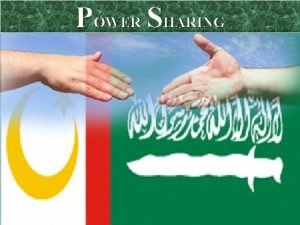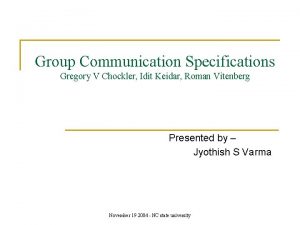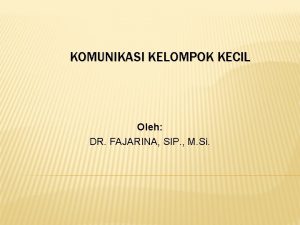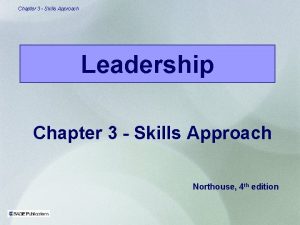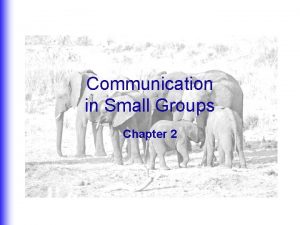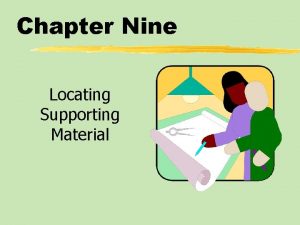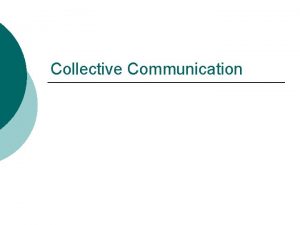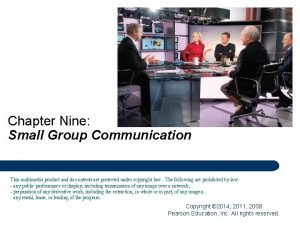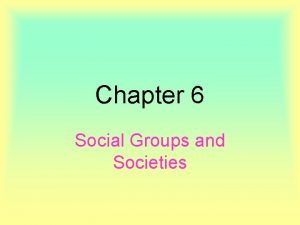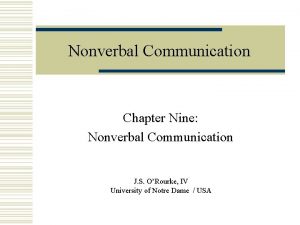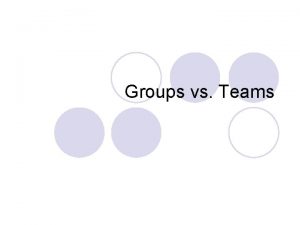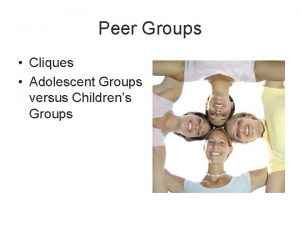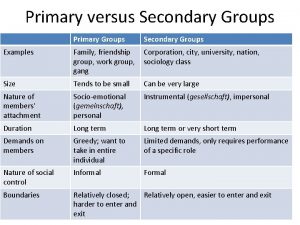COMMUNICATION IN SMALL GROUPS Chapter Nine POWER DEFINED






















- Slides: 22

COMMUNICATION IN SMALL GROUPS Chapter Nine

POWER DEFINED What is the definition of Power? �Power is the ability to influence the attainment of goals sought by yourself or others. What does it mean to say that power is group-centered?

POWER INDICATORS What are power indicators? �Power indicators are the ways in which relative degrees of power are communicated in groups. �There are three main categories of power indicators: general, verbal and nonverbal.

GENERAL INDICATORS: LABELING, FOLLOWING, AND OPPOSING 1. Those who define others exercise control 2. Whose decisions are followed 3. Who opposes significant change

VERBAL INDICATORS: POWERLESS AND POWERFUL SPEECH Power is reflected in the way we speak. Some examples of speech patterns perceived to be relatively powerless include: Hedges: “Perhaps the best way to proceed is…” 2. Hesitations: “Well, um, the important thing to remember is ah…” 3. Tag Questions: “The meeting will be at noon, okay? ” 4. Disclaimers: “This is probably not very important, but…” 5. Excessive Politeness: “I’m extremely sorry to barge in like this…” 1.

NONVERBAL INDICATORS: SILENT POWER �Space �Posture and gestures �Touch �Eye contact �Objects and tangible materials

POWER RESOURCES What is a power resource? �Anything that enables individuals to move toward their own goals or interfere with another’s actions.

FIVE POWER RESOURCES There are five primary resources relevant to group situations: 1. 2. 3. 4. 5. Information Expertise Punishments and Rewards Personal Qualities Legitimate Authority

INFORMATION: RESTRICTED OR SCARCE �Information assumes value or usefulness when it is perceived to be unavailable. �Information becomes unavailable primarily from restrictions and scarcity.

CAPITALIZING ON INFORMATION AS POWER The competent communicator can capitalize on information as a power resource as follows: Provide useful but scarce or restricted information to the group. 2. Be certain information is accurate. 1.

EXPERTISE: KNOWING AND SHOWING For expertise to function as a power resource, a minimum of two conditions must be met: 1. The group must be convinced that the person has the requisite skills, abilities, knowledge, and background to function as a real expert. 2. The person who has been accorded status as an expert must demonstrate trustworthiness.

CAPITALIZING ON POWER OF EXPERTISE Assuming that a group member has expertise useful for the group, here’s how that individual could capitalize on the power potential of expertise: 1. 2. 3. 4. Maintain skills, abilities, and knowledge currency. Demonstrate trustworthiness and credibility. Be certain of your facts before advising the group. Don’t assume an air of superiority.

REWARDS AND PUNISHMENTS �Although punishment is a source of power, there can be serious drawbacks to using it to influence group members. �An extrinsic reward can diminish intrinsic motivation to behave in certain ways by offering money, prestige, praise, etc. �An intrinsic reward is enjoying what one does for its own sake.

USING PUNISHMENT AND REWARDS CAREFULLY Here are some guidelines: Punishment should be used as a last resort. Punishment should be appropriate to the act. Punishment should be swift and certain. Be generous with praise that is warranted Determine what rewards group members value before offering any. 6. Administer both punishment and rewards equitably and fairly. 1. 2. 3. 4. 5.

PERSONAL QUALITIES �Any group member can be charismatic. �Charisma, however, is not determined objectively. �Learning to be charismatic is difficult. �Charismatic leaders typically exhibit extraordinary communication skills.

LEGITIMATE AUTHORITY Those who aspire to be competent communicators while capitalizing on legitimate authority as a power resource can try the following: 1. 2. 3. 4. Become an authority figure. Gain legitimacy. Encourage participative decision making. Act ethically.

ADDRESSING POWER IMBALANCES The last four alternatives are the ways less powerful members attempt to balance the power in groups. Let’ look at the pros and cons of each alternative for balancing power: 1. 2. 3. 4. 5. Compliance: Group Power Alliance: Coalition Formation Resistance: Dragging Your Feet Defiance: Digging In Your Heels Significance: Self-Empowerment

SIGNIFICANCE: SELF EMPOWERMENT Becoming more significant to the group can occur in two primary ways: by developing assertiveness and personal power resources. �Assertiveness and aggressiveness are not the same. �Aggression is any physical or verbal behavior intended to hurt or destroy. �Assertiveness is the ability to communicate the full range of your thoughts and emotions with confidence and skill.

MORE ON ASSERTIVENESS �Assertiveness is not a strategy of resistance. �We use assertiveness to assure that our individual rights, and responsibilities are not submerged or ignored by the group. �Don’t always assume that assertiveness is always appropriate. There are cultural differences.

INCREASING PERSONAL POWER: MENTORING AND NETWORKING What are mentors? �Mentors are knowledgeable individuals who have achieved some success in their profession or jobs and who assist individuals trying to get started in a line of work. What is networking? �Networking is a form of group empowerment. Individuals with similar backgrounds, skills, and goals come together on a regular basis and share information that will assist members in pursuing goals.

VIDEO CASE STUDY: Crimson Tide

VIDEO CASE STUDY: Crimson Tide
 Well defined set
Well defined set How are ethnic groups and religious groups related
How are ethnic groups and religious groups related Power traiangle
Power traiangle Washington naval conference
Washington naval conference Nine-power treaty
Nine-power treaty Mbti team building workshops
Mbti team building workshops It divides organisms into small groups
It divides organisms into small groups Making small groups work
Making small groups work Dispersive power of grating is directly proportional to
Dispersive power of grating is directly proportional to Power is rate of
Power is rate of Define majoritarianism
Define majoritarianism Free floating interaction pattern
Free floating interaction pattern Communication groups
Communication groups Group communication in health and social care
Group communication in health and social care Komunikasi kelompok kecil
Komunikasi kelompok kecil An introduction to group communication
An introduction to group communication Dewey's reflective thinking model
Dewey's reflective thinking model Leadership skills are defined in the chapter as
Leadership skills are defined in the chapter as How is rhetoric defined in this chapter
How is rhetoric defined in this chapter The new deal affects many groups
The new deal affects many groups Chapter 9 section 3 interest groups at work
Chapter 9 section 3 interest groups at work Chapter 10 comparing two populations or groups answer key
Chapter 10 comparing two populations or groups answer key Chapter 9 section 2 types of interest groups
Chapter 9 section 2 types of interest groups










